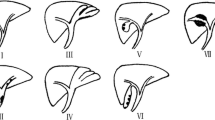Abstract
Purpose: Intraductal papillary neoplasm of the bile duct (IPN-B) is known as a premalignant lesion of invasive cholangiocarcinoma. The purpose of this study was for radiologic–pathologic correlation of morphologic features of IPN-B and to correlate the subclassifications with biological behavior in regard to the bile duct wall invasion. Materials and Methods: A pathologist classified gross morphology of 75 cases (44 men and 31 women, age range, 39–85) of histopathologically proven IPN-B into polypoid, cast-like, superficial-spreading, and cyst-forming type. Preoperative images were retrospectively reviewed by two observers independently and classified the gross appearance of intraductal tumors into the four types. Results: The pathologist classified macroscopic appearances of 75 cases of IPN-B into polypoid type in 26, cast-like intraductal growth in 17, superficial-spreading growth in 21, and cyst-forming type in 11. Two observers classified image findings in accordance with pathologist’s classification in 58 and 57 (77% and 76%) among the 75 cases of IPN-B, respectively; 18 and 19 of 26 cases of polypoid type, 14 and 14 of 17 cases of cast-like growth type, 16 and 19 of 21 cases of superficial-spreading type, 10 and 5 of 11 cases of cyst-forming type, respectively. Interobserver agreement for subclassification of tumor morphology was in the category of good agreement (k = 0.651). There was no correlation between morphological subclassification and tendency to invasive cholangiocarcinoma. Conclusion: IPN-Bs can be classified morphologically into polypoid, cast-like growth, superficial-spreading, and cystic type, but there is no correlation between the types and tendency to invasive cholangiocarcinoma.







Similar content being viewed by others
Abbreviations
- IPN-B:
-
Intraductal papillary neoplasm of the bile duct
- BilIN:
-
Biliary intraepithelial neoplasia
References
Okuda K, Nakanuma Y, Miyazaki M (2002) Cholangiocarcinoma: recent progress. Part 1: epidemiology and etiology. J Gastroenterol Hepatol 17:1049–1055
Patel T (2001) Increasing incidence and mortality of primary intrahepatic cholangiocarcinoma in the United States. Hepatology 33:1353–1357
Zen Y, Sasaki M, Fujii T, et al. (2006) Different expression patterns of mucin core proteins and cytokeratins during intrahepatic cholangiocarcinogenesis from biliary intraepithelial neoplasia and intraductal papillary neoplasm of the bile duct—an immunohistochemical study of 110 cases of hepatolithiasis. J Hepatology 44:350–358
Nakanuma Y, Sripa B, Vantanasapt V, et al. (2000) Intrahepatic cholangiocarcinoma. In: Hamilton SR, Aaltonen LA (eds) World Health Organization classification of tumors. Pathology and genetics of tumours of the digestive system. Lyon, France: IARC Press, pp 173–180
Shimonishi T, Sasaki M, Nakanuma Y (2000) Precancerous lesions of intrahepatic cholangiocarcinoma. J Hepatobiliary Pancreat Surg 7:542–550
Chen TC, Nakanuma Y, Zen Y, et al. (2001) Intraductal papillary neoplasia of the liver associated with hepatolithiasis. Hepatology 34:651–658
Nakanuma Y, Sasaki M, Ishikawa A, et al. (2002) Biliary papillary neoplasm of the liver. Histol Histopathol 17:851–861
Shimonishi T, Zen Y, Chen TC, et al. (2002) Increasing expression of gastrointestinal phenotypes and p53 along with histologic progression of intraductal papillary neoplasia of the liver. Hum Pathol 33:503–511
Lim JH, Jang K-T (2009) Mucin producing bile duct tumors: radiological-pathological correlation and diagnostic strategy. J Hepatobiliary Pancreat Surg 17:223–229
Chung YE, Kim MJ, Park YN, et al. (2009) Varying appearance of cholangiocarcinoma: radiologic-pathologic correlation. Radiographics 29:683–700
Han JK, Lee JM (2004) Intrahepatic intraductal cholangiocarcinoma. Abdom Imaging 29:558–564
Lim JH, Yoon KH, Kim SH, et al. (2004) Intraductal papillary mucinous tumor of the bile ducts. Radiographics 24:53–67
Lee SS, Kim MH, Lee SK, et al. (2004) Clinicopathologic review of 58 patients with biliary papillomatosis. Cancer 100:783–793
Zen Y, Fujii T, Itatsu K, et al. (2006) Biliary papillary tumors share pathological features with intraductal papillary mucinous neoplasm of the pancreas. Hepatology 44:1333–1343
Kim HJ, Kim MH, Lee SK, et al. (2000) Mucin hypersecreting bile duct tumor characterized by a striking homology with an intraductal papillary mucinous tumor (IPMT) of the pancreas. Endoscopy 32:389–393
Oshikiri T, Kashimura N, Katanuma A, et al. (2002) Mucin-secreting bile duct adenoma-clinicopathological resemblance to intraductal papillary mucinous tumor of the pancreas. Dig Surg 19:324–327
Shibahara H, Tamada S, Goto M, et al. (2004) Pathologic features of mucin-producing bile duct tumors. Two histopathologic categories as counterparts of pancreatic intraductal papillary mucinous neoplasms. Am J Surg Pathol 28:327–338
Kloppel G, Kosmahl M (2006) Is the intraductal papillary mucinous neoplasia of the biliary tract a counterpart of pancreatic papillary mucinous neoplasm? J Hepatol 44:249–250
Albores-Saavedra J, Murakata L, Kruger JL, et al. (2000) Noninvasive and minimally invasive papillary carcinomas of the extrahepatic ducts. Cancer 89:508–515
Suh KS, Roh HR, Koh YT, et al. (2000) Clinicopathological features of the intraductal growth type of peripheral cholangiocarcinoma. Hepatology 31:12–17
Tajima Y, Kuroki T, Fukuda K, et al. (2004) An intraductal papillary component is associated with prolonged survival after hepatic resection for intrahepatic cholangiocarcinoma. Br J Surg 91:99–104
Yeh CN, Jan YY, Yeh TS, et al. (2004) Hepatic resection of the intraductal papillary type of peripheral cholangiocarcinoma. Ann Surg Oncol 11:606–611
Paik KY, Heo JS, Choi SH, et al. (2008) Intraductal papillary neoplasm of the bile ducts: the clinical features and surgical outcome of 25 cases. J Surg Oncol 97:508–512
Liver Cancer Study Group of Japan (2000). The general rule for the clinical and pathological study of primary liver cancer, 4th edn. Tokyo: Kanehara
Lim JH (2003) Cholangiocarcinoma: morphologic classification according to growth pattern and imaging findings. AJR Am J Roentgenol 181:819–827
Lim JH, Jang K-T, Choi D (2008) Biliary intraductal papillary mucinous neoplasm presenting only as dilation of the hepatic lobar or segmental bile ducts: imaging features in six patients. AJR Am J Roentgenol 191:778–782
Lim JH, Kim MH, Kim TK, et al. (2003) Papillary neoplasms of the bile duct that mimic biliary stone disease. Radiographics 23:447–455
Lim JH, Jang KT, Rhim H, et al. (2007) Biliary cystic intraductal papillary mucinous tumor and cystadenoma/cystadenocarcinoma: differentiation by CT. Abd Imaging 32:644–651
Author information
Authors and Affiliations
Corresponding author
Rights and permissions
About this article
Cite this article
Kim, H., Lim, J.H., Jang, K.T. et al. Morphology of intraductal papillary neoplasm of the bile ducts: radiologic–pathologic correlation. Abdom Imaging 36, 438–446 (2011). https://doi.org/10.1007/s00261-010-9636-2
Published:
Issue Date:
DOI: https://doi.org/10.1007/s00261-010-9636-2




